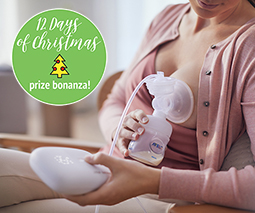I struggled to produce breastmilk – then I found supply line feeding

Before I became pregnant, I assumed that the size of one’s breasts might be an indicator of milk supply. I figured my C-cup boobs would breastfeed my children exclusively and “naturally” just like in the photos. (You know the ones I’m talking about!)
Now that I have babies, I’ve learned one must never assume anything when it comes to kids, your body and motherhood! Not ever!
My boobs looked like they were ready for the job
My first baby arrived more sleepy than hungry. He was quite content suckling on the colostrum my breasts were making.
Colostrum is the first milk a woman breasts make. There’s not much of it, but it’s loaded with antibodies and immunoglobulins which help protect newborns from bacteria and viruses.
It wasn’t until my son was a few days old that I realised I would probably never be a poster mum for breastfeeding. When my milk came in, my boobs ballooned. From the outside it looked like I would be able to feed most of Australia, but sadly that was not the case.
Although my son and I managed to get the hang of breastfeeding, it was my supply that let us down. I felt like a failure. Why was my body not making enough food for my baby?

My journey from breast is best to fed is best
At this stage of my mothering career, I wasn’t aware that formula is perfectly fine. All I had heard was breast is best, breast is best, breast is best! Now, many years later, I believe fed is best. As long as your baby is happy and thriving, who cares how they are nourished?
Back then, I sought out a wonderful lactation consultant who embraced my desire (and society’s push) to breastfeed exclusively. She suggested I pump after every feed. This is no mean feat, especially during night feeds, yet pump is what I did.
I managed to get myself a nice little stash of ‘spare’ breastmilk, which my lactation consultant encouraged me to feed to my baby through a ‘supply line’.
In came the supply line
A supply line, also known as a nursing trainer or supplemental nursing system (SNS) – which is what I used – is a feeding device that allows your baby to get extra milk as they breastfeed.
How does it work? It goes a little something like this:
A very thin tube is attached to a storage bottle or bag, which contains either breastmilk or formula. The other end of the tube is taped near the nipple, which allows the tube to enter the baby’s mouth when they latch on to the breast.
This not only feeds the baby extra milk, but it also helps stimulate a woman’s breastmilk production. With SNS, the milk flow is controlled by the elevation of the bottle and the circumference of tubing used. Nursing trainers, however, allow milk to flow only when a baby is sucking.
Genius device
SNS made it possible for me to feed my baby the ‘spare’ breastmilk while I was breastfeeding him, thereby also stimulating my milk production.
I have met other women who have used supply lines happily and very successfully. Some suffered from low supply and wanted to stimulate their supply or avoid bottles. Others temporarily used supply lines to reestablish supply after a period of not breastfeeding.
I even met one mother who used a supply line with donor milk, building up her breastmilk supply so she could then successfully breastfeed her adopted daughter.
It’s hard work, though
The device is quite finicky, so putting it together, getting the bottle at the right height (to get the desired milk flow), taping the tube to the right part of the breast near the nipple, and ensuring baby takes the tube into his mouth while latching onto the breast can be challenging.
The device also needs to be washed and sterilised after every single feed. The set-up can also make it tricky to feed while you are in public places. I am sure women do it, but I never attempted it, which resulted in us staying home (or rushing home) for every feed.
This might seem limiting, but I felt strongly that supply line supplementing was what I needed to do at the time. I’m sure it helped my postnatal mental health to choose this option.
Things changed with baby number two
When baby number two came along, 21 months later, I had the same supply struggles. I pumped after every feed and fed the ‘spare’ breastmilk to my baby via the supply line.
This time I had a toddler in tow. I quickly realised that using a bottle to top-up the extra breastmilk was a far easier option. We even fed in public places!
At the end of the day, as long as you fill your baby’s tummy, it doesn’t matter how you feed.
Jennifer Hacker Pearson is a mother of three and the author of ‘I Wish Someone Had Told Me – Unspoken truths about what really happens to women during labour, childbirth and the first few weeks of motherhood’. You can find out more about Jennifer on her website and buy the book here.









